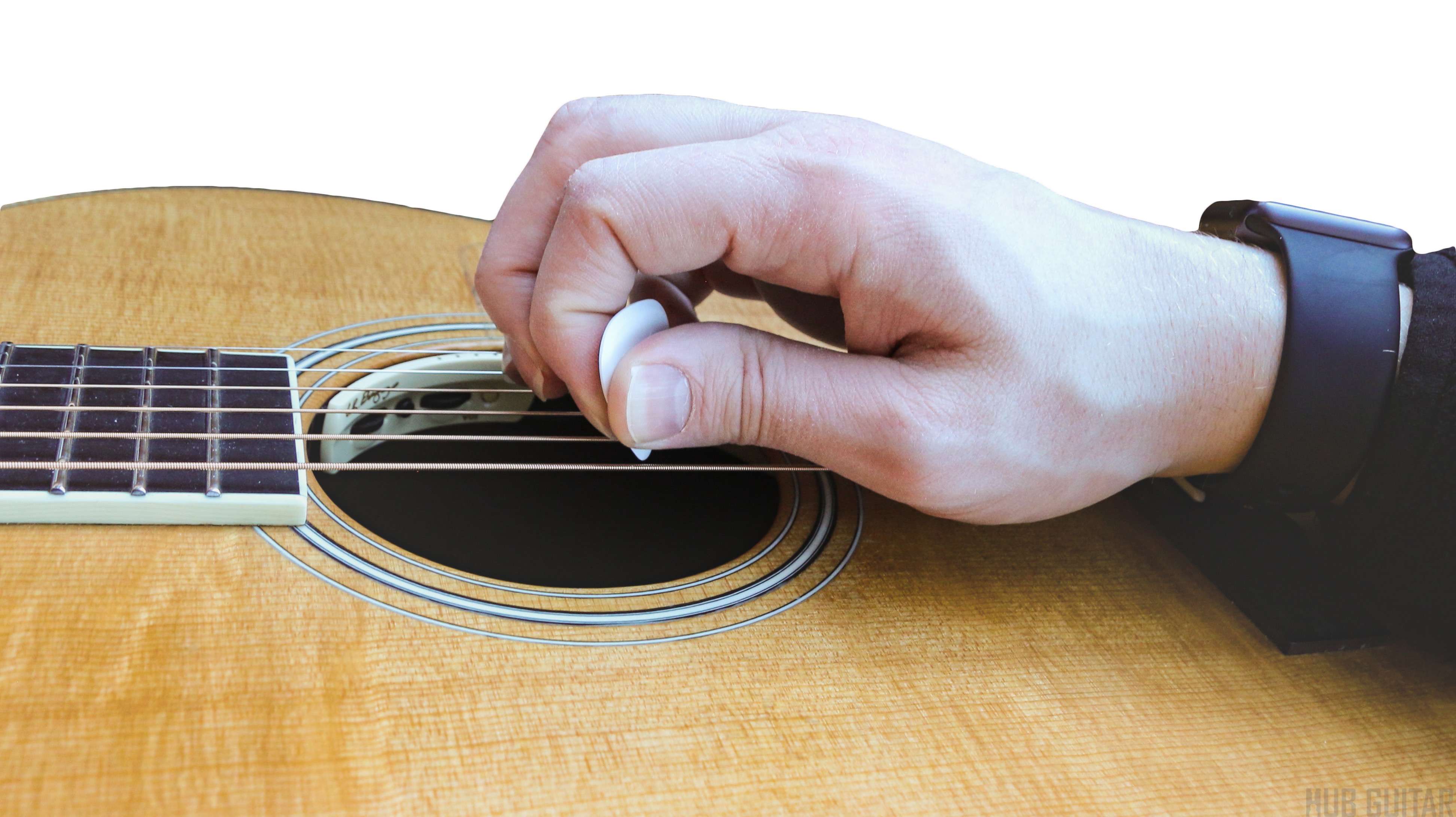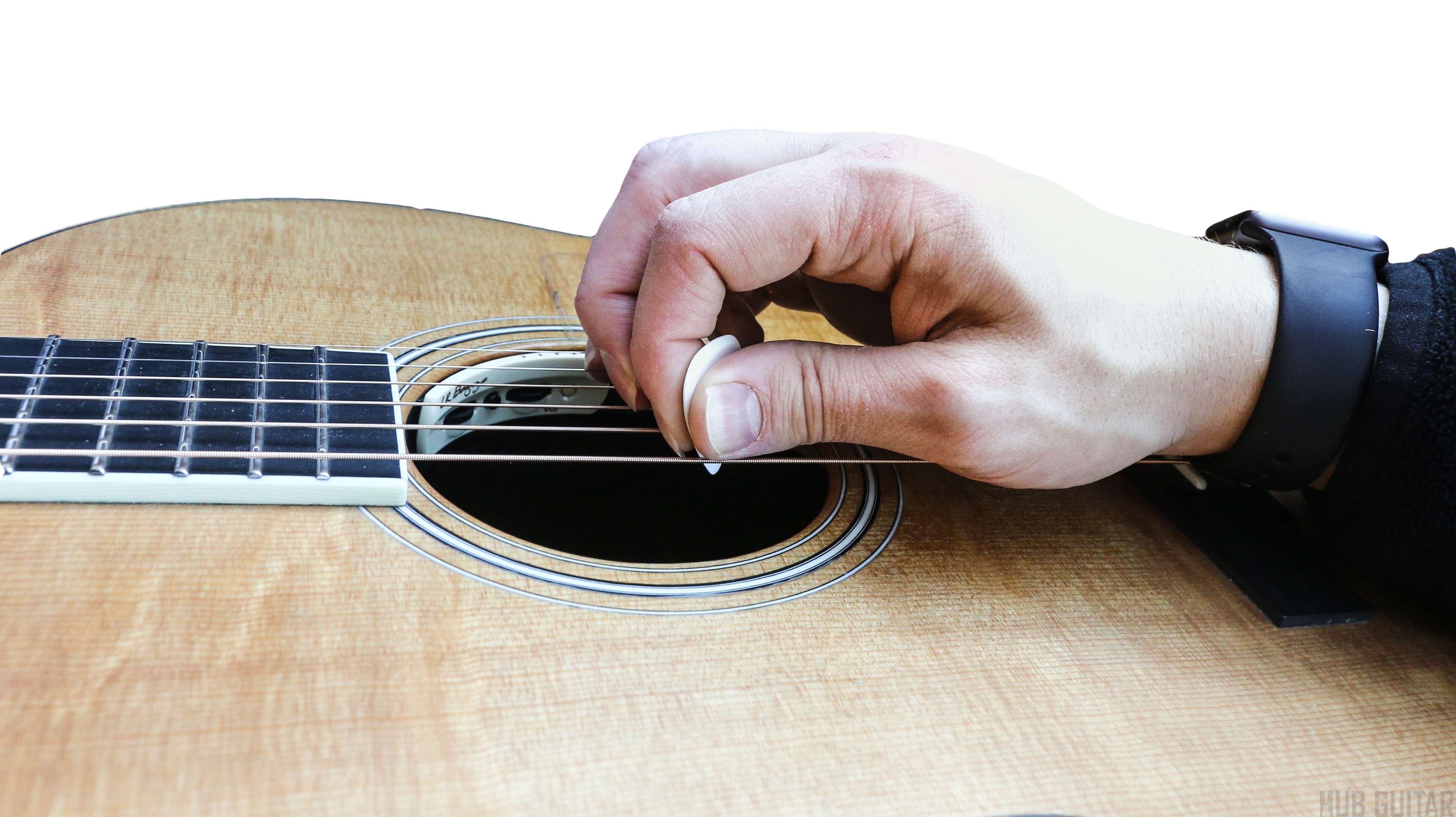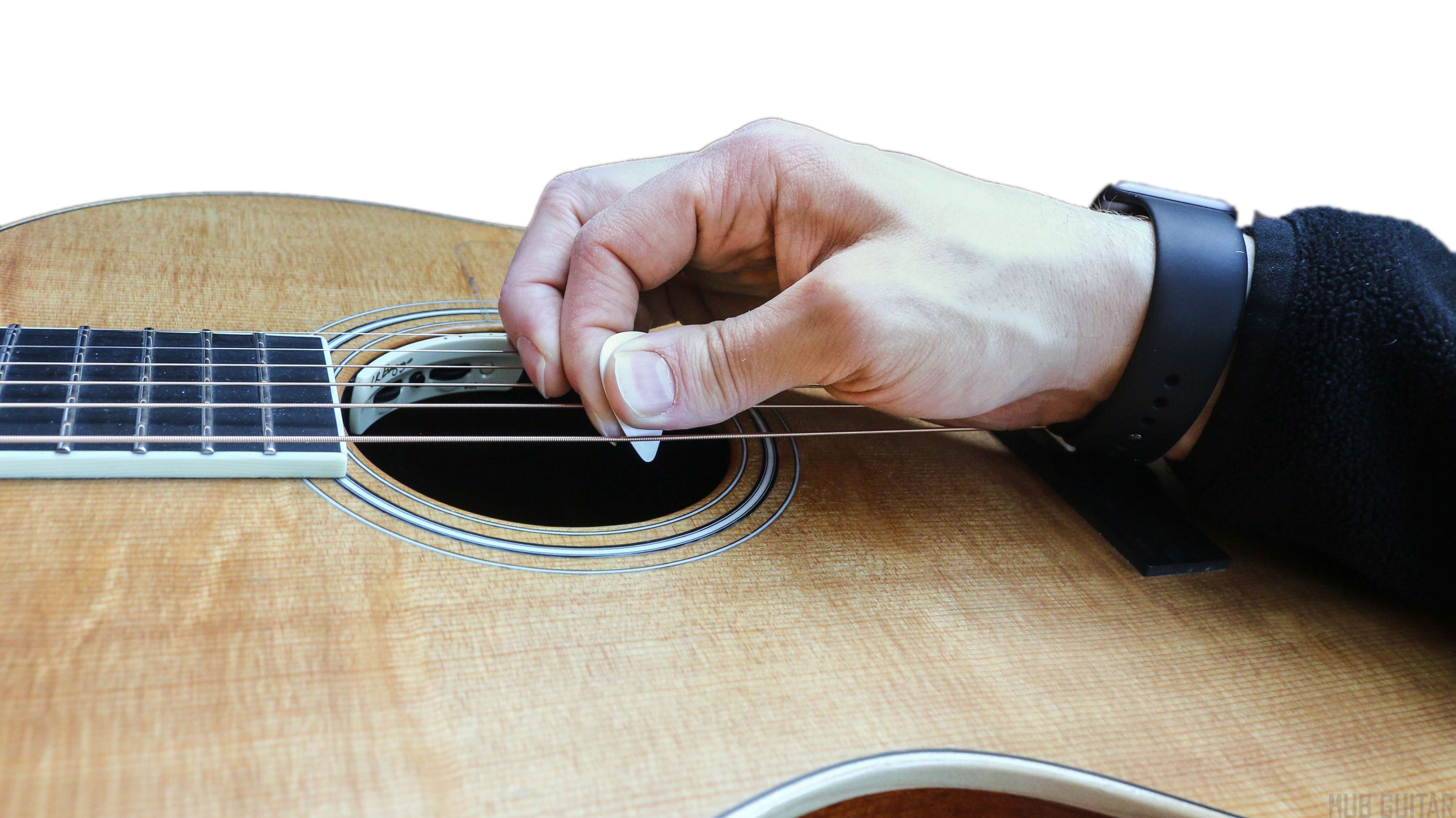How to Hold the Pick

Hi I am Grey and this is Hub Guitar Let's talk about how to hold the pick. You might be wondering if you even need to use a pick at all. If you want to strum cords, or to play any sort of melody or lead line or improvisation, you will want to use a pick. Unless you will only play nylon string guitar. A complete study of the steel-string guitar, electric or acoustic requires a basic knowledge of how to use the pick. The pick you use matters quite a bit. Initially, you probably do not want to use one that is too heavy too thin. For normal use I recommend picks that are about .88 mm thick. But you can use very thin picks to practice strumming chords, even as thin as .44mm. To grip the pick, extend your fingers of your picking hand and place the pick on your index finger, with the pointed part facing out towards your finger pads. Now curl the fingers in and, using your thumb, secure the pick in this position. Do not hold the pick too tightly. It actually should flex and bounce around a bit as it comes up off of the strings. Until you get used to this, you will likely drop the pick a lot of times. And that acts as a stimulus to encourage you to hold the pick tightly, but if you learn how to hold the pick correctly, you will not need a tight grip. Here's another counterintuitive point: the pick is not held completely straight. Because the surface of the pic that will contact the strings is actually not the pointed part of it, but only the very edge. So to use this edge of the pic to make contact with the strings, you need to hold it at a slight angle. You will need an angle both for down strokes, and for up strokes. It's very difficult to describe the exact angle. Look at photos, watch videos, and try yourself. Imagine that the pick is a razor blade and you will shave the strings with it. It's this edge of the pick you want to touch the string with. Don't dig too deep into the guitar strings. Only a tiny bit of material will protrude past the guitar string. And don't pluck the strings to hard. The strings practically pluck themselves. Learning proper picking technique takes time. But keeping these ideas in mind will help you learn faster.
(Hold on loosely, but don’t let go.)
The “proper” way to hold the pick is often one of the first question a learner has when beginning to play the guitar.
Although it’s important to consider correct technique, it’s not really good to worry about it too much, either. If worrying about the proper way to hold the pick is holding you back, just move on for now. You can always come back and revisit these instructions from time-to-time.
Though good technique is important, good technique is something you build slowly, over time.
Pick Rule #1: Don’t Hold It Firmly
This may seem counterintuitive. Especially after you drop the pick into the soundhole of the guitar for the 100th time, and you’re cursing and shaking the guitar to try to get it to come out again.
But good pick technique requires that you don’t hold the pick too firmly. In fact, the correct grip is very gentle.
So how do you avoid dropping the pick?
If you’re holding the pick at a good angle, the force of striking a string will be balanced by the leverage of the pick angle. Because you hold it at an angle and strike at an angle and use only a small amount of the pick’s surface, the force absorbed by the pick is very small.
Pick Rule #2: Hold The Pick at an Angle

It is not the point or the flat face (or rear) of the pick that contacts the string, but the bevelled edge between them.
The pick has a physical appearance that gives a deceptive impression of how it should be used.
At first glance, the guitar pick appears to be a tool for digging into the string. And even the word “pick” seems to give the impression that we’re going to get underneath that string and pull it up.
But the pick doesn’t really pull up on the string from below. It approaches from the side—at an angle— and only a small bit of the pick’s surface contacts the string. Because it’s at an angle, the string glides easily off of the pick.
And the point or tip of the pick is really not used the way you might think. The purpose of the point of the pick is to allow the string to glide off of the surface of the pick. It’s not a sharp edge for grabbing the string. It’s the lift-off point of a runway.
Pick Rule #3: Don’t Dig In Too Deep

Only a tiny bit of material is needed to activate the strings.

Digging in too much will make playing the guitar difficult, frustrating, and terrible sounding.
Only the very edge of the tip of the pick is needed to activate a string, whether you’re strumming or plucking individual notes. So the pick should stay on the surface of the strings, and never go too deep into them.
It is difficult to perfect a technique allowing you to activate musical notes with minimum effort and energy expended. But it is worth trying. And what better time than now?
Your playing should be efficient:
- Use the smallest motion
- Use the least force
- Expend the least energy and effort
- Make the smallest contact between surfaces
Pick Rule #4: Don’t Pick Too Hard
It doesn’t require alot of force to pick the string. In fact, rather than say “pick”, it might be better to say that the pick is a device whose role is to “activate” the string. A string is a steel wire, strung, resting between two elevated points, and wound with quite a bit of pressure. A string has the potential to create the musical sound already waiting to be activated. The role of the pick is much more passive than you might think. The potential to make sound is contained already in the string. The role of the pick is to gently “activate” the string’s sound potential.
Special Equipment
Consider buying a set of Dava Guitar Grip Picks[?]Affiliate Link if you’re having trouble hanging on to your picks.
For beginners learning to strum, a Dunlop .38mm Nylon Pick[?]Affiliate Link is just the prescription.
If interested, consider reading this overly detailed breakdown of many different guitar picks.
Coda
Examine your pick technique and compare it to the suggestions given here.
If you don’t get it down 100%, don’t worry. Continually revisit these suggestions and you will be able to gradually incorporate them into your playing.
 As the creator of Hub Guitar, Grey has compiled hundreds of guitar lessons, written several books, and filmed hundreds of video lessons. He teaches private lessons in his Boston studio, as well as via video chat through TakeLessons.
As the creator of Hub Guitar, Grey has compiled hundreds of guitar lessons, written several books, and filmed hundreds of video lessons. He teaches private lessons in his Boston studio, as well as via video chat through TakeLessons.